Question Number 60313 by ajfour last updated on 19/May/19
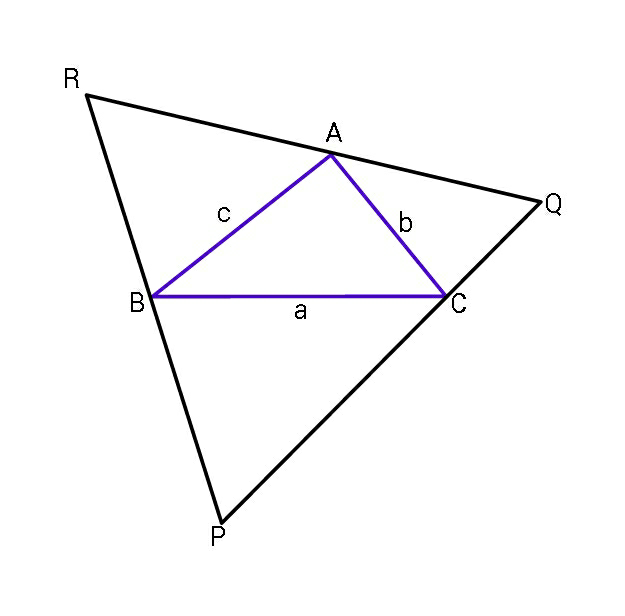
Commented by ajfour last updated on 19/May/19

$$\mathrm{Find}\:\mathrm{side}\:\mathrm{length}\:\boldsymbol{{l}}\:\mathrm{of}\:\mathrm{largest}\:\mathrm{equilateral} \\ $$$$\mathrm{triangle}\:\mathrm{circumscribing}\:\mathrm{a}\:\mathrm{given} \\ $$$$\bigtriangleup\mathrm{ABC}\:\left(\mathrm{sides}\:\mathrm{a},\mathrm{b},\mathrm{c}\right). \\ $$
Answered by ajfour last updated on 19/May/19

$$\:\:\mathrm{This}\:\mathrm{question}\:\mathrm{wasn}'\mathrm{t}\:\mathrm{solved} \\ $$$$\mathrm{satisfactorily}\:\mathrm{before},\:\mathrm{i}\:\mathrm{just}\:\mathrm{now} \\ $$$$\mathrm{find}\:\:\:{l}_{{max}} =\sqrt{\frac{\mathrm{2}}{\mathrm{3}}\left({a}^{\mathrm{2}} +{b}^{\mathrm{2}} +{c}^{\mathrm{2}} \right)+\frac{\mathrm{8}}{\:\sqrt{\mathrm{3}}}\left(\bigtriangleup_{\mathrm{ABC}} \right)}\:\:. \\ $$
Commented by ajfour last updated on 21/May/19
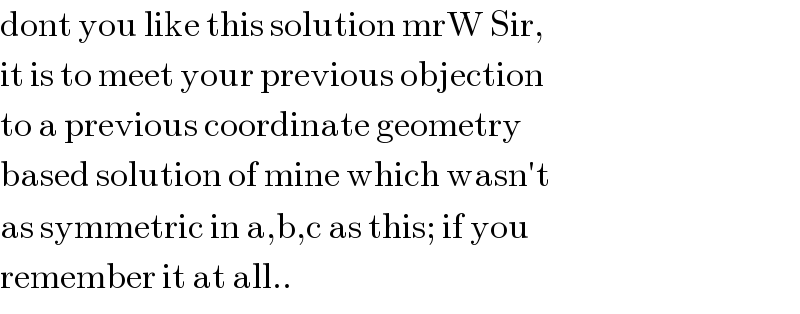
$$\mathrm{dont}\:\mathrm{you}\:\mathrm{like}\:\mathrm{this}\:\mathrm{solution}\:\mathrm{mrW}\:\mathrm{Sir}, \\ $$$$\mathrm{it}\:\mathrm{is}\:\mathrm{to}\:\mathrm{meet}\:\mathrm{your}\:\mathrm{previous}\:\mathrm{objection} \\ $$$$\mathrm{to}\:\mathrm{a}\:\mathrm{previous}\:\mathrm{coordinate}\:\mathrm{geometry} \\ $$$$\mathrm{based}\:\mathrm{solution}\:\mathrm{of}\:\mathrm{mine}\:\mathrm{which}\:\mathrm{wasn}'\mathrm{t} \\ $$$$\mathrm{as}\:\mathrm{symmetric}\:\mathrm{in}\:\mathrm{a},\mathrm{b},\mathrm{c}\:\mathrm{as}\:\mathrm{this};\:\mathrm{if}\:\mathrm{you} \\ $$$$\mathrm{remember}\:\mathrm{it}\:\mathrm{at}\:\mathrm{all}.. \\ $$
Commented by mr W last updated on 22/May/19
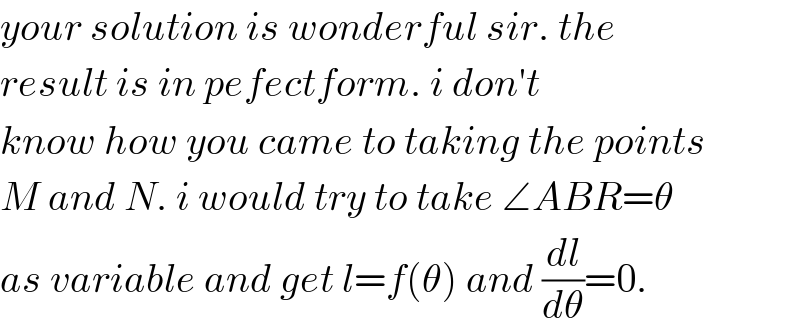
$${your}\:{solution}\:{is}\:{wonderful}\:{sir}.\:{the} \\ $$$${result}\:{is}\:{in}\:{pefectform}.\:{i}\:{don}'{t} \\ $$$${know}\:{how}\:{you}\:{came}\:{to}\:{taking}\:{the}\:{points} \\ $$$${M}\:{and}\:{N}.\:{i}\:{would}\:{try}\:{to}\:{take}\:\angle{ABR}=\theta \\ $$$${as}\:{variable}\:{and}\:{get}\:{l}={f}\left(\theta\right)\:{and}\:\frac{{dl}}{{d}\theta}=\mathrm{0}. \\ $$
Commented by ajfour last updated on 21/May/19

$$\mathrm{constancy}\:\mathrm{of}\:\mathrm{the}\:\mathrm{vertex}\:\mathrm{angles}\:\mathrm{at} \\ $$$$\mathrm{P},\mathrm{Q},\mathrm{R}\:\:\mathrm{led}\:\mathrm{me}\:\mathrm{into}\:\mathrm{thinking}\:\mathrm{this}\: \\ $$$$\mathrm{Sir}! \\ $$
Commented by mr W last updated on 21/May/19
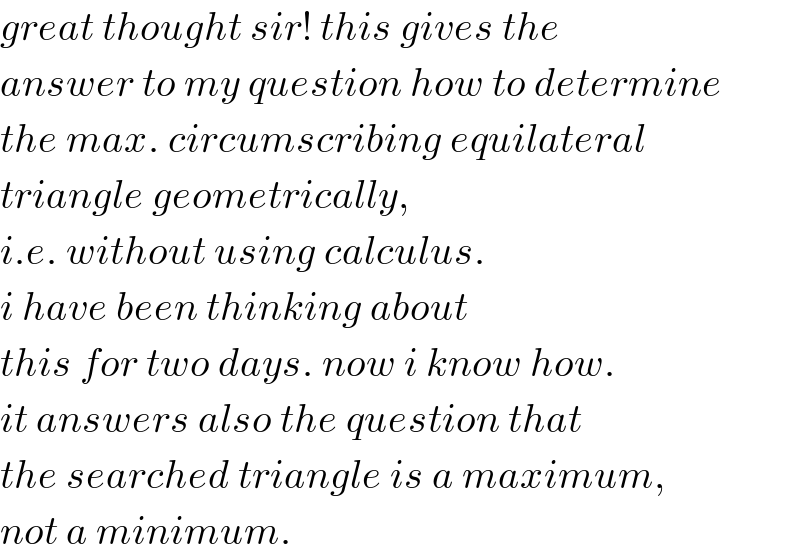
$${great}\:{thought}\:{sir}!\:{this}\:{gives}\:{the} \\ $$$${answer}\:{to}\:{my}\:{question}\:{how}\:{to}\:{determine} \\ $$$${the}\:{max}.\:{circumscribing}\:{equilateral} \\ $$$${triangle}\:{geometrically}, \\ $$$${i}.{e}.\:{without}\:{using}\:{calculus}. \\ $$$${i}\:{have}\:{been}\:{thinking}\:{about} \\ $$$${this}\:{for}\:{two}\:{days}.\:{now}\:{i}\:{know}\:{how}. \\ $$$${it}\:{answers}\:{also}\:{the}\:{question}\:{that} \\ $$$${the}\:{searched}\:{triangle}\:{is}\:{a}\:{maximum}, \\ $$$${not}\:{a}\:{minimum}. \\ $$
Commented by mr W last updated on 21/May/19

$${my}\:{result}\:{using}\:{geometrical}\:{method} \\ $$$${is}\:{the}\:{same}\:{as}\:{your}\:{method}\:{using} \\ $$$${calculus},\:{see}\:{below}. \\ $$
Answered by ajfour last updated on 20/May/19
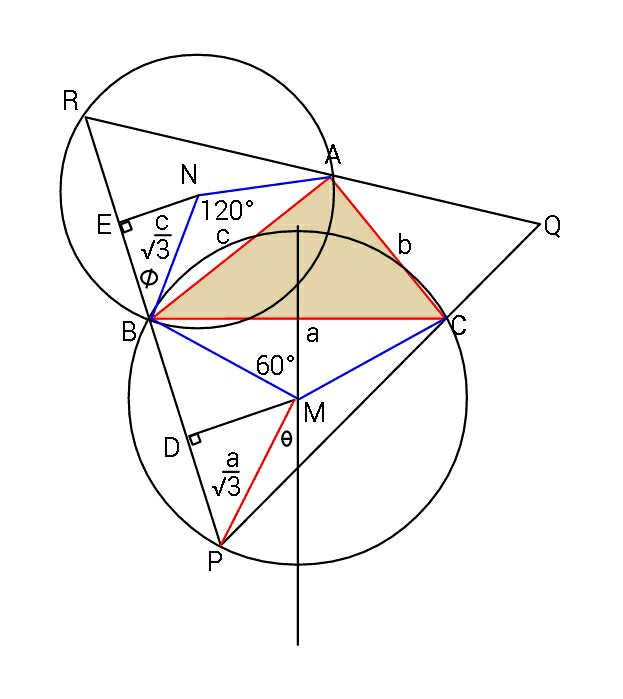
Commented by ajfour last updated on 20/May/19

$$\mathrm{cos}\:\mathrm{30}°\:=\:\frac{\mathrm{BC}/\mathrm{2}}{\mathrm{CM}}\:\:\:\Rightarrow\:\:\frac{\sqrt{\mathrm{3}}}{\mathrm{2}}=\frac{\mathrm{a}}{\mathrm{2}}×\frac{\mathrm{1}}{\mathrm{CM}} \\ $$$$\Rightarrow\:\:\:\mathrm{PM}=\mathrm{CM}=\frac{\mathrm{a}}{\:\sqrt{\mathrm{3}}} \\ $$$$\:\:\:\:\:\left(\mathrm{similarly}\:\:\mathrm{BN}=\frac{\mathrm{c}}{\:\sqrt{\mathrm{3}}}\:\:\right)\:\:\:…..\left(\mathrm{ii}\right) \\ $$$$\angle\mathrm{BMP}=\mathrm{180}°−\mathrm{60}°−\theta \\ $$$$\mathrm{BP}=\mathrm{2PMsin}\:\left(\frac{\angle\mathrm{BMP}}{\mathrm{2}}\right) \\ $$$$\mathrm{BP}=\frac{\mathrm{2a}}{\:\sqrt{\mathrm{3}}}\mathrm{sin}\:\left(\mathrm{60}°−\frac{\theta}{\mathrm{2}}\right)\:\:\:\:\:\:\:\:……\left(\mathrm{i}\right) \\ $$$$\mathrm{let}\:\angle\mathrm{B}=\beta\:\:\mathrm{and}\:\mathrm{since}\:\angle\mathrm{PBR}=\mathrm{180}°, \\ $$$$\phi+\mathrm{30}°+\beta+\mathrm{30}°+\left(\mathrm{30}°+\frac{\theta}{\mathrm{2}}\right)=\mathrm{180}° \\ $$$$\Rightarrow\:\:\:\phi=\mathrm{90}°−\beta−\frac{\theta}{\mathrm{2}} \\ $$$$\:\:\mathrm{BR}\:=\:\mathrm{2BNcos}\:\phi \\ $$$$\:\:\:\:\:\:\:\:\:\:\:=\frac{\mathrm{2c}}{\:\sqrt{\mathrm{3}}}\mathrm{sin}\:\left(\beta+\frac{\theta}{\mathrm{2}}\right) \\ $$$$\mathrm{let}\:\mathrm{side}\:\mathrm{of}\:\mathrm{equilateral}\:\bigtriangleup\mathrm{PQR}\:\mathrm{be}\:\boldsymbol{{l}}. \\ $$$$\:{l}=\:\mathrm{BP}+\mathrm{BR} \\ $$$$\:\:\:\:=\:\frac{\mathrm{2a}}{\:\sqrt{\mathrm{3}}}\mathrm{sin}\:\left(\mathrm{60}°−\frac{\theta}{\mathrm{2}}\right)+\frac{\mathrm{2c}}{\:\sqrt{\mathrm{3}}}\mathrm{sin}\:\left(\beta+\frac{\theta}{\mathrm{2}}\right) \\ $$$$\Rightarrow{l}\sqrt{\mathrm{3}\:}={a}\left(\sqrt{\mathrm{3}}\mathrm{cos}\:\frac{\theta}{\mathrm{2}}−\mathrm{sin}\:\frac{\theta}{\mathrm{2}}\right) \\ $$$$\:\:\:\:\:\:\:\:\:\:\:+\mathrm{2c}\left(\mathrm{sin}\:\beta\mathrm{cos}\:\frac{\theta}{\mathrm{2}}+\mathrm{cos}\:\beta\mathrm{sin}\:\frac{\theta}{\mathrm{2}}\right) \\ $$$$\:\:\:\:{l}\sqrt{\mathrm{3}}\:=\left(\mathrm{2ccos}\:\beta−\mathrm{a}\right)\mathrm{sin}\:\frac{\theta}{\mathrm{2}} \\ $$$$\:\:\:\:\:\:\:\:\:\:\:\:+\left(\mathrm{2csin}\:\beta+\mathrm{a}\sqrt{\mathrm{3}}\right)\mathrm{cos}\:\frac{\theta}{\mathrm{2}} \\ $$$$\:\:\frac{{d}\left({l}\sqrt{\mathrm{3}}\right)}{{d}\theta}=\mathrm{0}\:\:\:\Rightarrow \\ $$$$\:\:\:\:\:\:\mathrm{tan}\:\frac{\theta}{\mathrm{2}}=\frac{\mathrm{2ccos}\:\beta−\mathrm{a}}{\mathrm{2csin}\:\beta+\mathrm{a}\sqrt{\mathrm{3}}} \\ $$$$\:\:{l}\sqrt{\mathrm{3}}=\:\left(\mathrm{2}{c}\mathrm{cos}\:\beta−\mathrm{a}\right)\left\{\mathrm{sin}\:\frac{\theta}{\mathrm{2}}+\frac{\mathrm{cos}\:^{\mathrm{2}} \frac{\theta}{\mathrm{2}}}{\mathrm{sin}\:\frac{\theta}{\mathrm{2}}}\right\} \\ $$$$\:\:\:\:\:\:\:{l}\sqrt{\mathrm{3}}\:\:=\:\:\frac{\mathrm{2ccos}\:\beta−\mathrm{a}}{\mathrm{sin}\:\frac{\theta}{\mathrm{2}}} \\ $$$$\:{l}_{{max}} \sqrt{\mathrm{3}}\:=\:\sqrt{\left(\mathrm{2}{c}\mathrm{cos}\:\beta−\mathrm{a}\right)^{\mathrm{2}} +\left(\mathrm{2csin}\:\beta+\mathrm{a}\sqrt{\mathrm{3}}\right)^{\mathrm{2}} } \\ $$$$\:\:\:\:\:=\sqrt{\mathrm{4a}^{\mathrm{2}} +\mathrm{4c}^{\mathrm{2}} +\mathrm{4ac}\left(\sqrt{\mathrm{3}}\mathrm{sin}\:\beta−\mathrm{cos}\:\beta\right)} \\ $$$$\:\:\:\:\:=\:\sqrt{\mathrm{4a}^{\mathrm{2}} +\mathrm{4c}^{\mathrm{2}} +\mathrm{8}\sqrt{\mathrm{3}}\left(\frac{\mathrm{1}}{\mathrm{2}}\mathrm{acsin}\:\beta\right)−\mathrm{4ac}\left(\frac{\mathrm{a}^{\mathrm{2}} +\mathrm{c}^{\mathrm{2}} −\mathrm{b}^{\mathrm{2}} }{\mathrm{2ac}}\right)} \\ $$$$\:\:\Rightarrow\boldsymbol{{l}}\sqrt{\mathrm{3}}\:=\:\sqrt{\mathrm{2}\left(\boldsymbol{{a}}^{\mathrm{2}} +\boldsymbol{{b}}^{\mathrm{2}} +\boldsymbol{{c}}^{\mathrm{2}} \right)+\mathrm{8}\sqrt{\mathrm{3}}\bigtriangleup_{\mathrm{ABC}} } \\ $$$$\:\:\_\_\_\_\_\_\_\_\_\_\_\_\_\_\_\_\_\_\_\_\_\_\_\_\_\_\_ \\ $$$$\:\:\:\boldsymbol{{l}}_{\boldsymbol{{max}}} =\sqrt{\frac{\mathrm{2}}{\mathrm{3}}\left(\boldsymbol{{a}}^{\mathrm{2}} +\boldsymbol{{b}}^{\mathrm{2}} +\boldsymbol{{c}}^{\mathrm{2}} \right)+\frac{\mathrm{8}}{\:\sqrt{\mathrm{3}}}\bigtriangleup_{\mathrm{ABC}} } \\ $$$$\:\:\_\_\_\_\_\_\_\_\_\_\_\_\_\_\_\_\_\_\_\_\_\_\_\_\_\_\_. \\ $$$$ \\ $$
Commented by ajfour last updated on 20/May/19
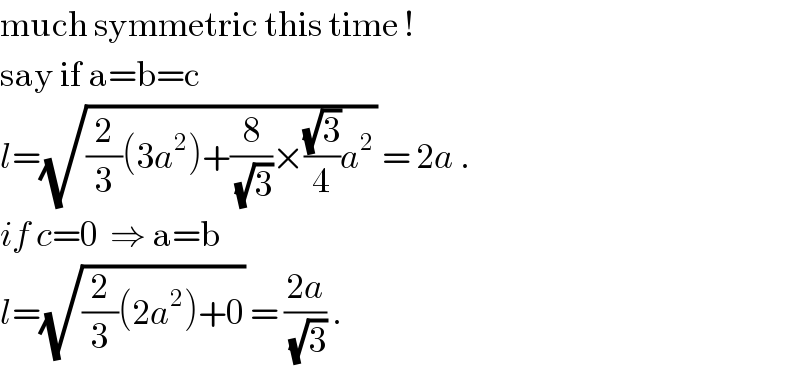
$$\mathrm{much}\:\mathrm{symmetric}\:\mathrm{this}\:\mathrm{time}\:!\:\:\:\:\:\:\:\:\:\:\:\:\:\: \\ $$$$\mathrm{say}\:\mathrm{if}\:\mathrm{a}=\mathrm{b}=\mathrm{c} \\ $$$${l}=\sqrt{\frac{\mathrm{2}}{\mathrm{3}}\left(\mathrm{3}{a}^{\mathrm{2}} \right)+\frac{\mathrm{8}}{\:\sqrt{\mathrm{3}}}×\frac{\sqrt{\mathrm{3}}}{\mathrm{4}}{a}^{\mathrm{2}} }\:=\:\mathrm{2}{a}\:. \\ $$$${if}\:{c}=\mathrm{0}\:\:\Rightarrow\:\mathrm{a}=\mathrm{b} \\ $$$${l}=\sqrt{\frac{\mathrm{2}}{\mathrm{3}}\left(\mathrm{2}{a}^{\mathrm{2}} \right)+\mathrm{0}}\:=\:\frac{\mathrm{2}{a}}{\:\sqrt{\mathrm{3}}}\:. \\ $$
Answered by mr W last updated on 21/May/19
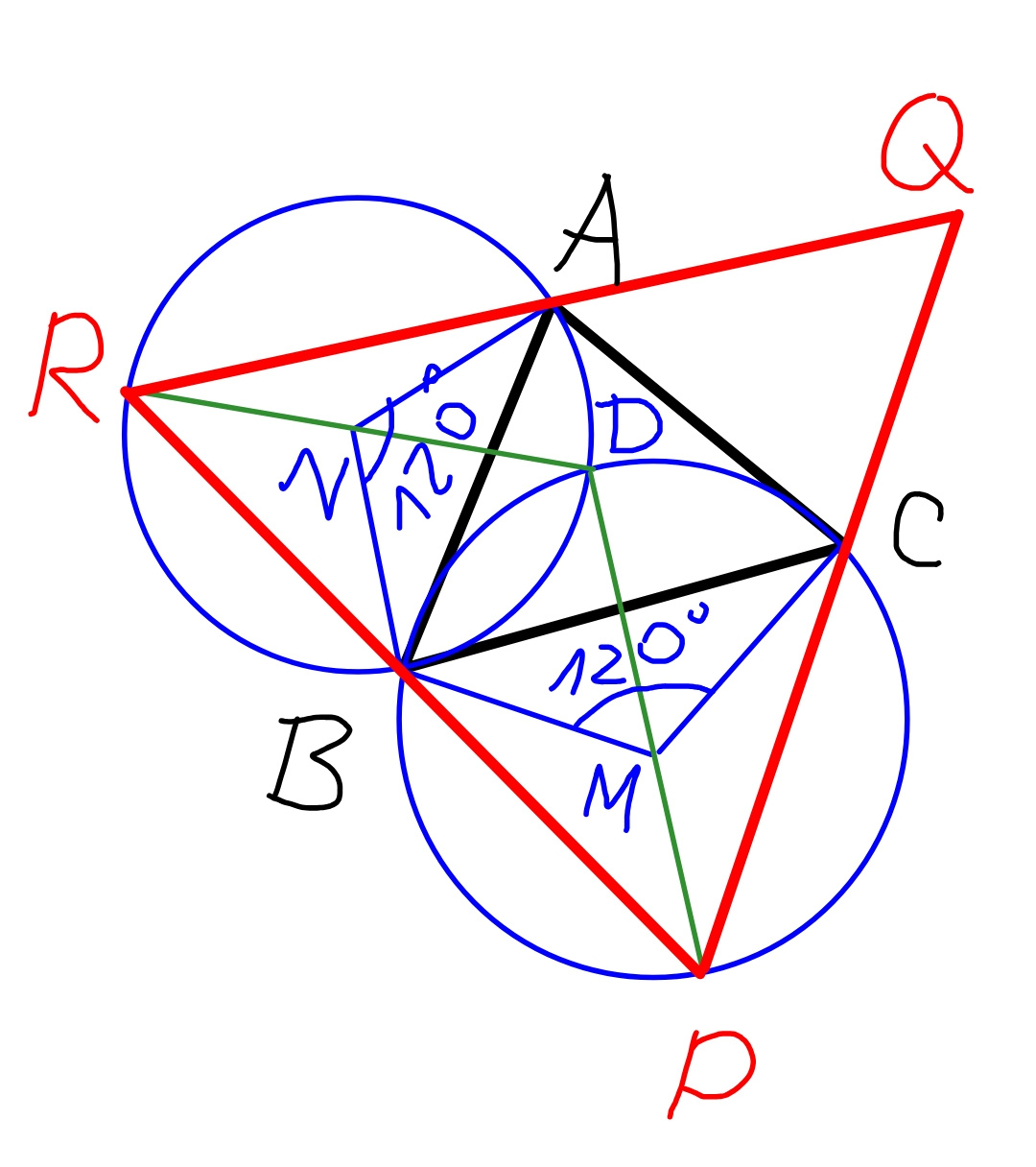
Commented by mr W last updated on 03/Feb/24

$${PQ}_{{max}} =\mathrm{2}{AB},\:{i}.{e}.\:{when}\:{CP}\:{and}\:{CQ}\:{are} \\ $$$${diameters}\:{of}\:{the}\:{circles}.\:{PQ}//{AB}. \\ $$
Commented by mr W last updated on 21/May/19
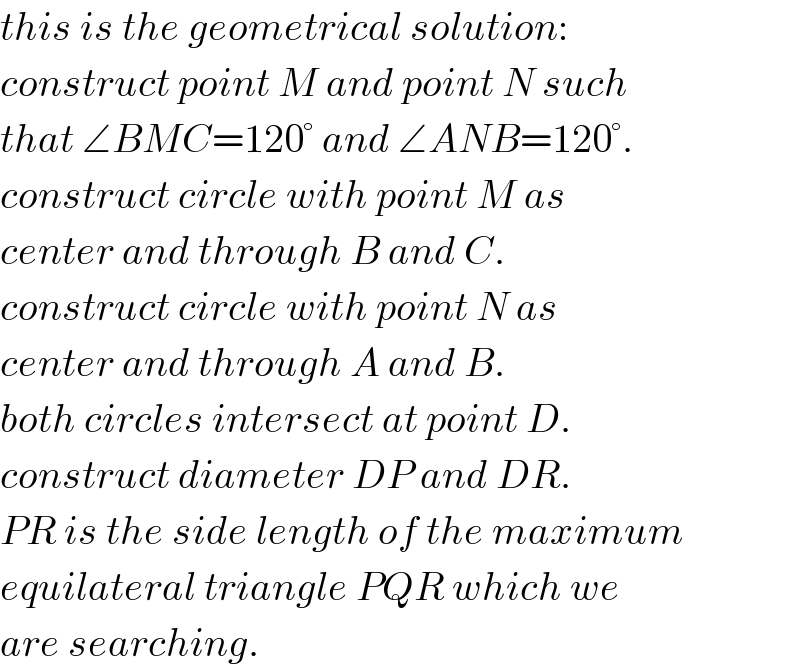
$${this}\:{is}\:{the}\:{geometrical}\:{solution}: \\ $$$${construct}\:{point}\:{M}\:{and}\:{point}\:{N}\:{such} \\ $$$${that}\:\angle{BMC}=\mathrm{120}°\:{and}\:\angle{ANB}=\mathrm{120}°. \\ $$$${construct}\:{circle}\:{with}\:{point}\:{M}\:{as} \\ $$$${center}\:{and}\:{through}\:{B}\:{and}\:{C}. \\ $$$${construct}\:{circle}\:{with}\:{point}\:{N}\:{as} \\ $$$${center}\:{and}\:{through}\:{A}\:{and}\:{B}. \\ $$$${both}\:{circles}\:{intersect}\:{at}\:{point}\:{D}. \\ $$$${construct}\:{diameter}\:{DP}\:{and}\:{DR}. \\ $$$${PR}\:{is}\:{the}\:{side}\:{length}\:{of}\:{the}\:{maximum} \\ $$$${equilateral}\:{triangle}\:{PQR}\:{which}\:{we} \\ $$$${are}\:{searching}. \\ $$
Commented by mr W last updated on 21/May/19
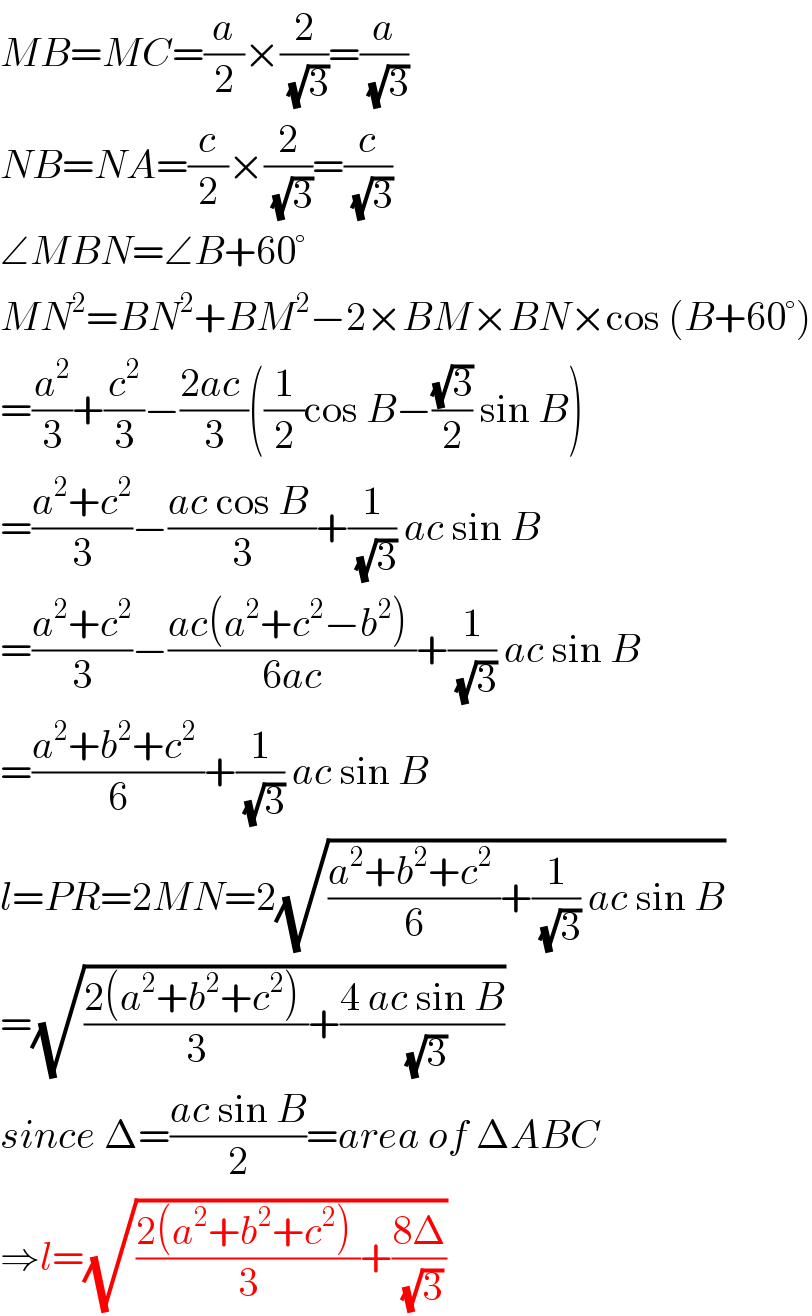
$${MB}={MC}=\frac{{a}}{\mathrm{2}}×\frac{\mathrm{2}}{\:\sqrt{\mathrm{3}}}=\frac{{a}}{\:\sqrt{\mathrm{3}}} \\ $$$${NB}={NA}=\frac{{c}}{\mathrm{2}}×\frac{\mathrm{2}}{\:\sqrt{\mathrm{3}}}=\frac{{c}}{\:\sqrt{\mathrm{3}}} \\ $$$$\angle{MBN}=\angle{B}+\mathrm{60}° \\ $$$${MN}^{\mathrm{2}} ={BN}^{\mathrm{2}} +{BM}^{\mathrm{2}} −\mathrm{2}×{BM}×{BN}×\mathrm{cos}\:\left({B}+\mathrm{60}°\right) \\ $$$$=\frac{{a}^{\mathrm{2}} }{\mathrm{3}}+\frac{{c}^{\mathrm{2}} }{\mathrm{3}}−\frac{\mathrm{2}{ac}\:}{\mathrm{3}}\left(\frac{\mathrm{1}}{\mathrm{2}}\mathrm{cos}\:{B}−\frac{\sqrt{\mathrm{3}}}{\mathrm{2}}\:\mathrm{sin}\:{B}\right) \\ $$$$=\frac{{a}^{\mathrm{2}} +{c}^{\mathrm{2}} }{\mathrm{3}}−\frac{{ac}\:\mathrm{cos}\:{B}\:}{\mathrm{3}}+\frac{\mathrm{1}}{\:\sqrt{\mathrm{3}}}\:{ac}\:\mathrm{sin}\:{B} \\ $$$$=\frac{{a}^{\mathrm{2}} +{c}^{\mathrm{2}} }{\mathrm{3}}−\frac{{ac}\left({a}^{\mathrm{2}} +{c}^{\mathrm{2}} −{b}^{\mathrm{2}} \right)\:}{\mathrm{6}{ac}}+\frac{\mathrm{1}}{\:\sqrt{\mathrm{3}}}\:{ac}\:\mathrm{sin}\:{B} \\ $$$$=\frac{{a}^{\mathrm{2}} +{b}^{\mathrm{2}} +{c}^{\mathrm{2}} \:}{\mathrm{6}}+\frac{\mathrm{1}}{\:\sqrt{\mathrm{3}}}\:{ac}\:\mathrm{sin}\:{B} \\ $$$${l}={PR}=\mathrm{2}{MN}=\mathrm{2}\sqrt{\frac{{a}^{\mathrm{2}} +{b}^{\mathrm{2}} +{c}^{\mathrm{2}} \:}{\mathrm{6}}+\frac{\mathrm{1}}{\:\sqrt{\mathrm{3}}}\:{ac}\:\mathrm{sin}\:{B}} \\ $$$$=\sqrt{\frac{\mathrm{2}\left({a}^{\mathrm{2}} +{b}^{\mathrm{2}} +{c}^{\mathrm{2}} \right)\:}{\mathrm{3}}+\frac{\mathrm{4}\:{ac}\:\mathrm{sin}\:{B}}{\:\sqrt{\mathrm{3}}}} \\ $$$${since}\:\Delta=\frac{{ac}\:\mathrm{sin}\:{B}}{\mathrm{2}}={area}\:{of}\:\Delta{ABC} \\ $$$$\Rightarrow{l}=\sqrt{\frac{\mathrm{2}\left({a}^{\mathrm{2}} +{b}^{\mathrm{2}} +{c}^{\mathrm{2}} \right)\:}{\mathrm{3}}+\frac{\mathrm{8}\Delta}{\:\sqrt{\mathrm{3}}}} \\ $$
Commented by ajfour last updated on 22/May/19

$$\mathrm{Why}\:\mathrm{this}\:\mathrm{way}\:\mathrm{we}\:\mathrm{get}\:\mathrm{the}\:\mathrm{maximum} \\ $$$$\mathrm{size}\:\bigtriangleup\mathrm{PQR}\:,\:\mathrm{i}\:\mathrm{fail}\:\mathrm{to}\:\mathrm{follow}\:\mathrm{the}\:\mathrm{reason}, \\ $$$$\mathrm{Sir};\:\mathrm{please}\:\mathrm{enlighten}.. \\ $$
Commented by mr W last updated on 22/May/19
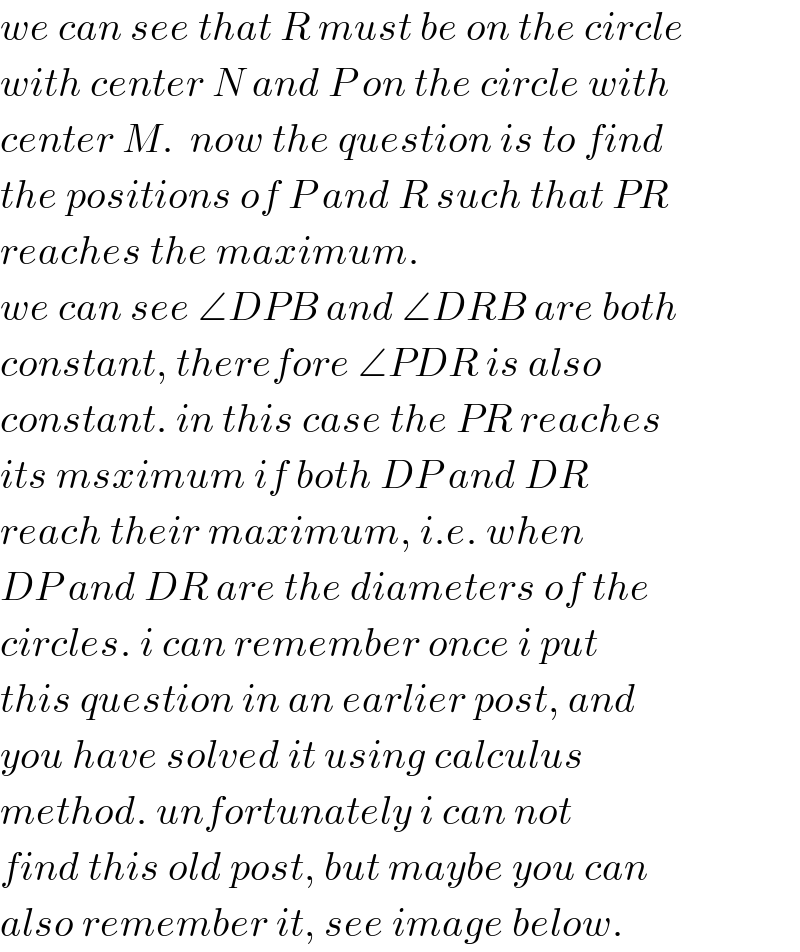
$${we}\:{can}\:{see}\:{that}\:{R}\:{must}\:{be}\:{on}\:{the}\:{circle} \\ $$$${with}\:{center}\:{N}\:{and}\:{P}\:{on}\:{the}\:{circle}\:{with} \\ $$$${center}\:{M}.\:\:{now}\:{the}\:{question}\:{is}\:{to}\:{find} \\ $$$${the}\:{positions}\:{of}\:{P}\:{and}\:{R}\:{such}\:{that}\:{PR} \\ $$$${reaches}\:{the}\:{maximum}. \\ $$$${we}\:{can}\:{see}\:\angle{DPB}\:{and}\:\angle{DRB}\:{are}\:{both} \\ $$$${constant},\:{therefore}\:\angle{PDR}\:{is}\:{also}\: \\ $$$${constant}.\:{in}\:{this}\:{case}\:{the}\:{PR}\:{reaches} \\ $$$${its}\:{msximum}\:{if}\:{both}\:{DP}\:{and}\:{DR} \\ $$$${reach}\:{their}\:{maximum},\:{i}.{e}.\:{when} \\ $$$${DP}\:{and}\:{DR}\:{are}\:{the}\:{diameters}\:{of}\:{the} \\ $$$${circles}.\:{i}\:{can}\:{remember}\:{once}\:{i}\:{put} \\ $$$${this}\:{question}\:{in}\:{an}\:{earlier}\:{post},\:{and} \\ $$$${you}\:{have}\:{solved}\:{it}\:{using}\:{calculus} \\ $$$${method}.\:{unfortunately}\:{i}\:{can}\:{not} \\ $$$${find}\:{this}\:{old}\:{post},\:{but}\:{maybe}\:{you}\:{can} \\ $$$${also}\:{remember}\:{it},\:{see}\:{image}\:{below}. \\ $$
Commented by mr W last updated on 22/May/19
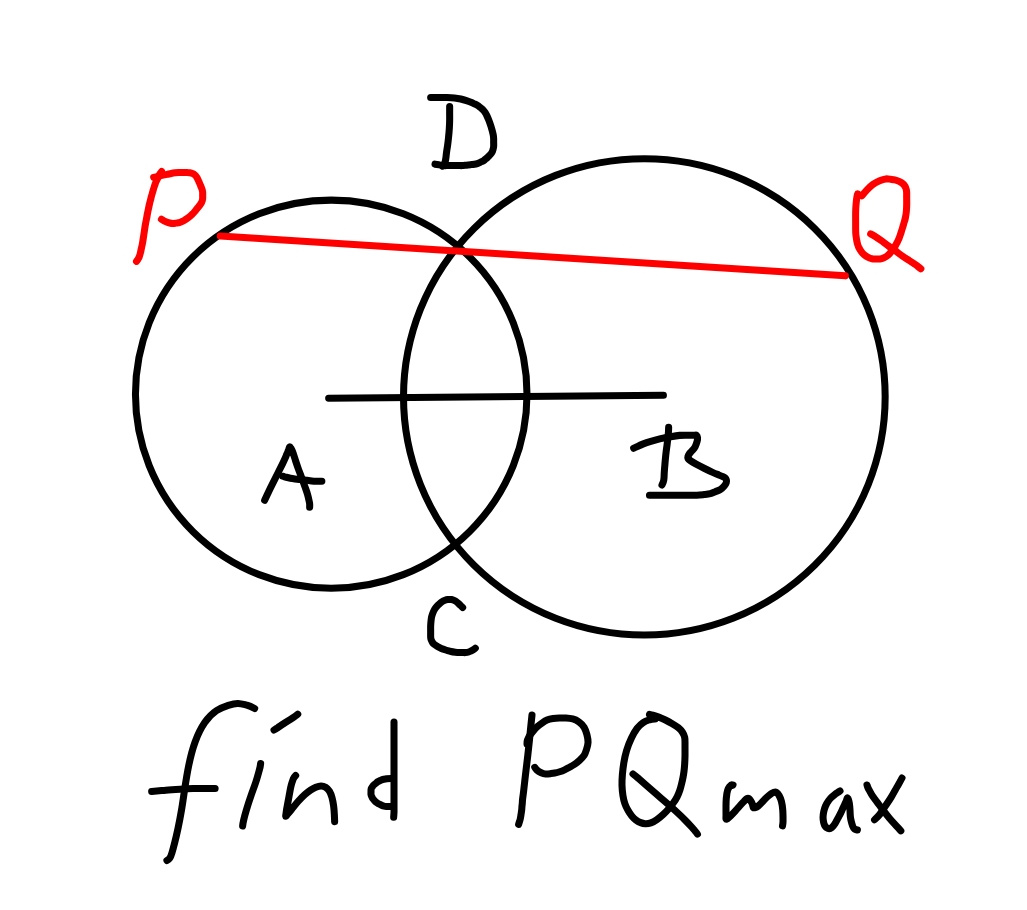
Commented by ajfour last updated on 22/May/19

$$\mathrm{Thanks}\:\mathrm{Sir},\:\mathrm{for}\:\mathrm{the}\:\mathrm{geometric}\:\mathrm{way}! \\ $$
Commented by mr W last updated on 22/May/19
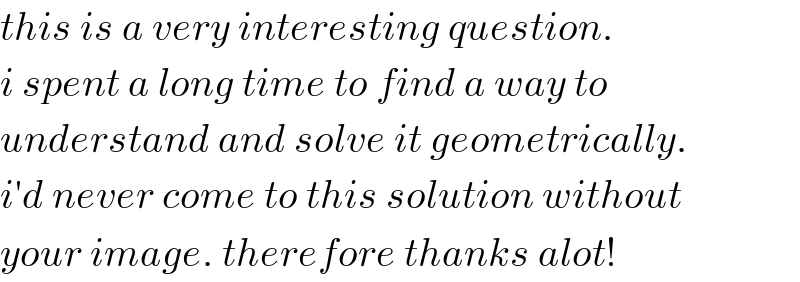
$${this}\:{is}\:{a}\:{very}\:{interesting}\:{question}. \\ $$$${i}\:{spent}\:{a}\:{long}\:{time}\:{to}\:{find}\:{a}\:{way}\:{to} \\ $$$${understand}\:{and}\:{solve}\:{it}\:{geometrically}. \\ $$$${i}'{d}\:{never}\:{come}\:{to}\:{this}\:{solution}\:{without} \\ $$$${your}\:{image}.\:{therefore}\:{thanks}\:{alot}! \\ $$
